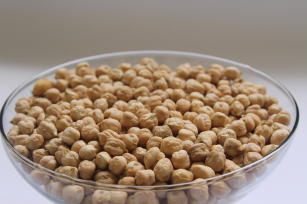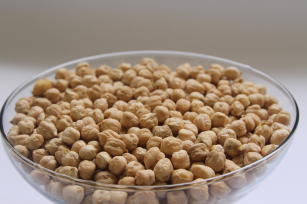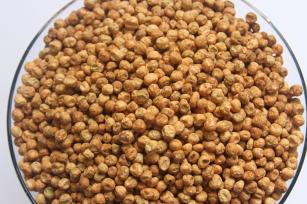 Busca de Notícias
Busca de Notícias
Brazilian research develops chickpeas aimed at Asian market
With favorable weather, dry spells and medium altitudes, some Brazilian regions are fit to produce chickpeas, a legume that is valued in Asian markets and in the Middle East. The development of such crop could open a billion-dollar market to Brazilian exports, besides meeting the domestic demand. Results obtained in plantations in Central Brazil have shown that the crop has had excellent performance in the winter period in irrigated and mechanized areas.
Researchers believe that this is a great opportunity for farmers, since the country still depends on imports to supply the product's annual consumption, eight thousand tons, and the Asian market is a major importer. According to the United Nations International Trade Statistics Database (UN Comtrade), India alone bought 873,000 tons of chickpeas from other countries in 2016, the equivalent to US$ 688 million or over R$ 2 billion.
With an eye on such potential, agricultural research has been assessing chickpea cultivars that are better adapted to Brazilian environmental conditions, testing the economic viability of the crop and searching for solutions to control pests and diseases that affect the crop's productivity and quality. New plant cultivars are also being developed.
In early 2017, Embrapa established a partnership with the Indian company United Phosphorus Limited (UPL) to set up experiments in six Brazilian states − Rio Grande d Sul, Minas Gerais, Goiás, Distrito Federal, Mato Grosso, and Mato Grosso do Sul - with the aim of assessing the production potential of four cultivars (two Indian ones and two Brazilian ones developed by Embrapa) at three different sowing times - April, May and June. As the chickpea cycle lasts about four months, the first harvests of these experiments have just started now, between the end of August and the beginning of September, and the expectation is to select the cultivars that better adapt to Brazilian environmental conditions.
For the researcher Warley Nascimento, general head of Embrapa Vegetables (Brasília, DF), the partnership is going to be profitable for both countries. “Based on the definition of more productive and adapted cultivars, it will be possible to foster national production, to minimize the need for imports and especially export grains to India and other Asian countries that have high consumption of this food.”
India has manifested an interest in importing pulses from Brazil during the late 2016 mission to Asia led by the minister of Agriculture, Livestock and Food Supply, Blairo Maggi. Pulses are a group of leguminous plants with dry grains that includes cowpeas, mung beans, lentils and chickpeas, for example. “This is an extraordinary opportunity to have Brazilians growers not only export, but also diversify their production systems, add value to production, and offer high quality foods to the population”, underscores the president of Embrapa, Maurício Lopes.
The South of Asia, including India, Sri Lanka, Bangladesh and Pakistan, represents approximately 40% of the world market for pulses. India is going through a special moment at which the population grows about 18 million inhabitants per year and the economy is in expansion. Higher income entails higher food consumption.
The vegetarian population in India is enormous, about a third of its 1.3 billion inhabitants, and the need for this type of food, e.g. protein-rich chickpeas, will only grow. “If we had production, we would certainly have a buyer's market. And Embrapa can help Brazil fill in this space, since the corporation has a great diversity of projects on several types of products and can quickly respond to such demand”, explains Maurício Lopes.
Brazil contrasts with India's vegetarian population. The country takes fifth place in the ranking of beef consumption per capita - each inhabitant consumes 35.8kg a year. It is estimated that about 10% of the population follows a vegetarian diet and the main legume consumed by Brazilians is beans. In light of the above, chickpea consumption in the country is still low, so that in 2016 Brazil imported about 8,000 tons at the cost of US$ 9.7 million, mainly from Mexico and Argentina − an expense that corresponds to less than 1% of Indian imports.
“Today, we already have genetic material and production technology to reach self-sufficiency and contemplate chickpea exports for the main consumer markets of the legume”, Nascimento states, as he points out that the crop has shown excellent performance in the winter period in irrigated and mechanized areas, and that itcan be an export alternative in addition to soybeans.
Last year, when India signaled an interest in importing legumes from Brazil, the Indian company UPL announced a great interest in investing in the country through the partnership with Embrapa, for the development and production of grains in Brazil to export to the Indian market, which has increasing and expressive demand for such products - the projection is that it can reach 30 million tons per year by 2030.
Farmer bets on chickpeas as alternative to beans
Despite Brazil not having a tradition in the cultivation of chickpeas, the garmer Osmar Artiaga, from Cristalina, Goiás, decided to invest in the crop as an option for the winter season under a central pivot irrigation system and with mechanized harvesting. During the summer, a hotter and moister season, the farmer grows soybean and maize, and in the period between harvests, he used to plant beans. However, after learning about the production technology and cultivars Embrapa made available, Artiaga bet in the advance of the research and established a partnership to assess the economic viability of commercial chickpea production in Central Brazil conditions.
Since 2011, he has opened his gates for a team of Embrapa technicians, and the results obtained have been so promising that the farm that was once called Futurama has been renamed Garbanzo, which means chickpeas in Spanish. Artiaga, as a matter of fact, chose the crop as the object of his Master's dissertation and conducted science-based experimental validation trials. “Chickpeas have proved to have lower water and fertilization requirements and, in the end, the cost of one hectare of chickpeas is about 40% lower than the cost of one hectare of beans”, Artiaga estimates.
And the farmer's calculations go beyond: both crops yield an average productivity of 2,500 kg/ha, but the price of a kilo of chickpeas can reach twice the amount obtained for beans. “It is rewarding to see a partner that started with a few dozen hectares reach the mark of 800 hectares in the current harvest season, which should yield around 2,000 tons”, comments the researcher Warley Nascimento.
And, considering that meeting Brazil's domestic demand would require 8,000 tons of chickpeas, a single grower would already be in the position to supply 20% of such amount. However,out of the total volume produced by Artiaga, a part is stored to become seeds for the next sowing, another part is traded to the processing industry, and a percentage is exported. Therefore, Nascimento emphasizes the importance of developing more research and to promoting the crop in the production sector. “Chickpeas have proved to be a viable alternative as an export product.”
Chickpea harvest in August in Osmar Artiaga's farm, in Cristalina
Partnership tests exporting it abroad
Good results have awakened the interest of other farmers and new partners. Next year, Ferrari Agriculture's branch in Campo Novo do Parecis, MT, which has experience with exporting popcorn maize and other agricultural products, is due to sow 5,000 hectares of chickpeas in Mato Grosso jointly with Artiaga.
“Fifteen years ago, Brazil imported popcorn maize from countries such as Argentina and the United States. Nowadays, we not only stopped importing but now we export it to several countries and we are highly competitive in the international market, with higher quality and better prices”, reports Vinícius Ferrari, general director of the company, as he states that the aim of the company is precisely to promote the production of crops that are generally imported in the domestic territory.
Ferrari reveals that the strategy outlined by the company to export chickpeas, especially to the Asian market, includes a range of activities from few exports in the first few years to publicizing the quality of the Brazilian grain and exhibiting the product in international fairs.
Not only chickpeas can be consumed worldwide, Ferrari stresses that customers abroad who also work with popcorn maize imports require chickpeas. “From a general analysis of quality and sales outlets, we can affirm that chickpeas have feasibly become an option for farmers' portfolio and could be as successful as popcorn maize in a short amount of time”, he thinks.
Dual-purpose cultivars in the horizon of research
The two national cultivars that are being sown by the production sector and assessed in the experimental trials in partnership with UPL were developed by Embrapa Vegetables. The cultivar Cícero, which stands out due to its vast adaptation to soil and weather conditions of Central Brazil, it was selected from Mexican lineages introduced in the 1990s.
The cultivar BRS Aleppo originated from a selection of genetic materials introduced by the International Center for Agricultural Research in Dry Areas (ICARDA) that was located in Syria, but which currently has headquarters in Lebanon because of the civil war. The cultivar - which pays homage to the Syrian city where ICARDA was headquartered - impresses due to its high productivity, which varies between 2,500 and 3,500 kg/ha, and the high level of tolerance to a complex of soil fungi. Both cultivars respond well to mechanized harvest and to irrigated cultivation in altitudes above 800 m.
At the moment, there are no licensing contracts for seed production in effect, but any interested parties can contact Embrapa Products and Market's office in Brasília, which is responsible for the production of genetic seeds and for answering enquiries from chickpea seed growers.
The research at its current stage for the selection and genetic improvement of chickpeas aim at obtaining materials with dual purpose: for consumption as dry grains or industrial use as rehydrated grains. “Currently, we have two cultivars at a validation stage, and we should soon make them available for the production sector”, Nascimento anticipates, as he mentions that the strategy is to offer a diversified portfolio of chickpea cultivars to meet different demands from farmers and processing companies.
Translation: Mariana Medeiros
Paula Rodrigues (MTb 61.403/SP)
Embrapa Vegetables
Press inquiries
hortalicas.imprensa@embrapa.br
Phone number: +55 61 3385-9109
Collaboration:
Gislene Alencar and Robinson Cipriano
Further information on the topic
Citizen Attention Service (SAC)
www.embrapa.br/contact-us/sac/




